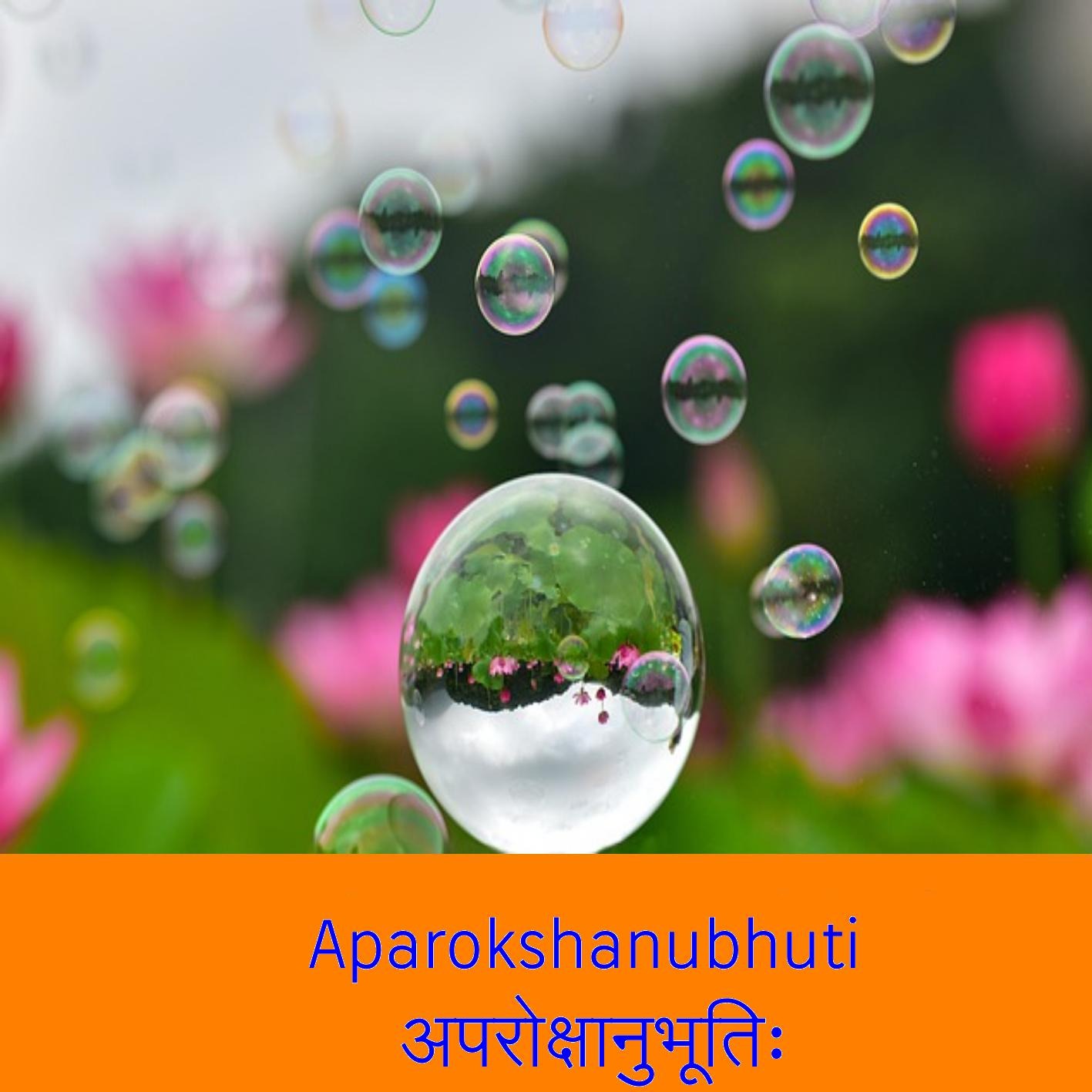Aparokshanubhuti-24
- Author
- Aurobind Padiyath
- Published
- Fri 22 Aug 2025
- Episode Link
- https://redcircle.com/shows/fe53db7f-360c-4b30-b69c-83084d6bcae3/episodes/f1ac6519-3008-4e50-a7d3-71fc139ca0d7
Verse No.65
Śaṅkara establishes the non-duality of Brahman and the illusoriness of the world using Upaniṣadic evidence, analogies, and reasoning.
1. Bhēdadṛṣṭi Doṣa (The Fault in Seeing Duality)
🔸 Sanskrit:
“किंच भेददृष्टेर्दोषश्रवणादपि कारणादभिन्नमेव कार्यमित्याह दोष इति।”
Segmented:
- किं च — moreover
- भेद-दृष्टेः दोष-श्रवणात् अपि — from the hearing of the fault in the view of difference
- कारणात् अभिन्नम् एव कार्यम् — the effect is indeed non-different from the cause
- इत्याह — thus it is said
- दोष इति — “fault”, so it is said
🔸 English:
Moreover, since the scriptures mention the faults of dualistic perception, the effect (world) must be non-different from its cause (Brahman).
🔹 Key Insight:
Seeing duality leads to fear and bondage. Hence, Śruti negates all difference to point toward non-duality.
2. Shruti Support – "मृत्योः स मृत्युमाप्नोति य इह नानेव पश्यति"
("He who sees difference goes from death to death")
This Śruti from Kaṭha Upaniṣad is a powerful declaration against the validity of dualistic perception.
3. Causal Non-Difference of the World from Brahman
🔸 Sanskrit:
“ब्रह्मण इति । बृहत्वादपरिच्छिन्नत्वाद्ब्रह्म तद्रूपात्परमात्मनः सर्वाणि भूतानि जायन्ते।”
Segmented:
- ब्रह्मण इति — [the world arises] from Brahman
- बृहत्वात् अपरिच्छिन्नत्वात् — because of infinitude and indivisibility
- ब्रह्म — Brahman
- तद्रूपात् — of that very nature
- परमात्मनः — of the Supreme Self
- सर्वाणि भूतानि — all beings
- जायन्ते — are born
🔸 English:
All beings arise from the infinite and indivisible Brahman. Hence, they are essentially non-different from it.
4. How can diverse things be Brahman?
🔸 Sanskrit:
“ननु नानानामरूपकर्मभेदेन विचित्राणि भूतानि कथं ब्रह्मात्मकानीति आशङ्क्य आह ब्रह्मैव इति।”
Segmented:
- ननु — but
- नाना-नाम-रूप-कर्म-भेदेन — with differences of name, form, and action
- विचित्राणि भूतानि — diverse beings
- कथं — how
- ब्रह्मात्मकानि — can be of the nature of Brahman?
- इति — thus
- आशङ्क्य — having this doubt
- आह — it is answered
- ब्रह्म एव — Brahman alone
🔸 English:
Though beings appear diverse in name, form, and action, they are essentially Brahman, says Śruti.
🔹 Insight:
Multiplicity is only apparent — it is due to nāma-rūpa (name and form), which are superimposed on the one reality.
5. Classic Shruti Support – "त्रयं वा इदं नाम रूपं कर्म"
(“This world is just name, form, and action”) — Bṛhadāraṇyaka Upaniṣad
6. Like Gold and Ornaments
"सुवर्णाज्जायमानस्य सुवर्णत्वं च शाश्वतम्। ब्रह्मणो जायमानस्य ब्रह्मत्वं च तथा भवेत्॥"
Just as ornaments made of gold never cease to be gold, all objects emerging from Brahman retain its Brahman-nature.
7. Even a Slight Notion of Duality Brings Fear
🔸 Sanskrit:
“स्वल्पमप्यन्तरम् उपास्योपासकरूपं भेदं कृत्वा कल्पयित्वा यः तिष्ठति तस्य भयम्।”
Segmented:
- स्वल्पम् अपि अन्तरम् — even the slightest distinction
- उपास्य-उपासक-रूपं भेदं — as between worshipper and worshipped
- कृत्वा — making
- कल्पयित्वा — imagining
- यः तिष्ठति — he who abides thus
- तस्य भयम् — for him, there is fear
🔸 English:
Even imagining a slight difference between oneself and Brahman leads to fear.
8. How can contradictory things like duality and non-duality have the same locus?
Śaṅkara resolves it through avastḥābheda (state-based distinctions):
In ignorance, duality seems real.
In knowledge, only non-duality shines forth.
9. “यस्मिन्सर्वाणि भूतान्यात्मैवाभूत्...” — Muṇḍaka / Īśa Upaniṣad
When one sees everything as the Self, there is no delusion or sorrow.
10. Analogies Used to Explain Mithyātva
- Gandharva-nagara: A mirage-like city in the sky
- Dream: Entirely internal, yet mistaken for real
- Snake on a rope: Superimposition due to ignorance
- Silver in nacre: A classic Advaita analogy for false appearance
11. Shruti on Name & Form — "वाचारंभणं विकारो नामधेयं..."
All modifications are only in name, with clay (mṛttikā) being the real substance. So too, all names and forms are just Brahman.
12. Jīva too is Name Only
"परे परब्रह्मणि जीवशब्दस्तथा..."
The word Jīva is only a name in the realm of ignorance. Upon realization of Brahman, the notion of Jīva ceases.
13. Is only the Jīva mithyā? What about the world?
“न केवलं जीव एव नाममात्रः किंतु सर्वं विश्वमपि ब्रह्मणि नाममात्रम्”
Not just the individual self, but the entire universe is only a name in Brahman — name without substance.
14. Purpose of Emphasizing Mithyātva
"नाममात्रप्रपंचस्य मिथ्यात्ववासनादार्ढ्याय..."
By showing that the world is only name-based appearance, the conviction in its unreality is strengthened.
15. “ज्ञेयमिति...” — Know that only Brahman is real
Because names are not real (name-abhaava), only Brahman — the substrate — is to be known as satya (truth).
16. Jīvanmukti is from removal of ignorance, not from death
“अज्ञाननिवृत्तिरेव जीवन्मुक्तिः न तु द्वैत-अदर्शनम्”
Liberation while living arises not from merely not seeing duality, but from the removal of ignorance.
Conclusion
All distinctions — Jīva, Jagat, duality, multiplicity — are mere superimpositions upon the non-dual Brahman. Through śruti, reason, and direct insight, Śaṅkara shows that the entire world is mithyā, and the one unchanging reality is Brahman, which is your very Self.
